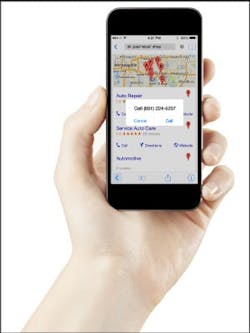According to a study by marketing analyst group BIA Kesley, businesses across all industries are pouring money into mobile advertising at astonishing rates, and the trend is only beginning. U.S. businesses spent roughly $11.4 billion on mobile marketing in 2013. By 2018, that number is expected to increase to $30.3 billion.
The reasons are simple: As mobile technology becomes more ingrained in everyday life, businesses will look to reach customers in the most effective way possible, says McKay Allen, inbound marketing manager for ContactPoint, the creators of the call data analytics system LogMyCalls.
But here’s the real point Allen hopes every single automotive service professional understands about this trend: Those mobile marketing dollars are being put to use for one reason only, and that’s to present a call to action to potential customers; they are geared to generate phone calls for your business.
In 2013, mobile marketing led to roughly 30 billion business calls, according to BIA Kesley. That number will skyrocket to 73 billion in 2018.
More mobile equals more phone leads—that’s great for repair businesses, right?
Well, maybe not.
As renowned customer service specialist Jeremy O’Neal of industry consulting firm AdvisorFix is quick to point out, the vast majority of shops struggle when it comes to converting phone calls to jobs.
“It’s definitely a large problem across the industry, and most shops don’t even realize that it’s a problem,” he says. “Without the right information and the right data showing shops where they’re falling short, most of them just keep making the same mistakes.”
Allen and ContactPoint have that data, and both Allen and O’Neal agree on a very simple solution for shop owners to ride this mobile wave into high sales numbers for their businesses.
‘The Next Frontier of Data’
LogMyCalls is a system that uses advanced algorithms to digitally analyze phone calls through voice recognition software. The program picks up on voice tone, key words and flow of the conversation, and rates how likely an “event” has occurred on a 0–100 scale. Events can be scheduling an appointment, offering a promotion, displaying empathy, or any other interaction a business is looking to measure. The higher the score, the more likely that event was to have taken place.
—Jeremy O’Neal, AdvisorFix
“This is the next frontier of data,” Allen says. “Marketers and companies have been gaining data about customers for so long, but phone calls have still lagged behind. This is the next big thing. There will be a day soon that, if you’re not collecting this data, you’ll be behind.”
Understanding customers’ needs and habits on the phone helps to convert sales, O’Neal says. It’s really that simple. If you know where you’re making mistakes, and can spot your missed opportunities, you can correct bad habits and convert more calls.
Now, the numbers: ContactPoint recently released an analysis of the more than 1 million phone calls tracked through its LogMyCalls Conversion Analytics engine in the second quarter of 2014. Many of its clients are in the automotive aftermarket; many of them the biggest names in the industry, Allen says.
What this data found was that 49 percent of all calls made to shops were actual sales inquiries—people looking to give shops business. Of those calls, more than 56 percent were not “converted” (they did not lead to an appointment, intended purchase or actual purchase). Of all calls received by businesses, only 29 percent were converted.
There are many factors, Allen says, ranging from the agent’s sales skills to the quality of the lead. But, overall, one glaring mistake stood out: Only 11 percent of all agents measured in these calls actually asked for the customer’s business.
“Think about that for a minute,” O’Neal says when given the number, which he felt might even be slightly higher than the average shop. “Your goal is to get them to call so you can get them into the shop, but you’re not even asking them to come in?”
According to the LogMyCalls data, calls are 10.4 times more likely to be converted if the service advisor simply asks for the business.
Mine (and Mind) Your Data
You can’t improve on the phone if you don’t know where you’re commonly making mistakes, O’Neal says. Call data can be a powerful tool. Recording calls to review later is also a great avenue toward staff improvement.
“But, it’s like with anything, if you pay for this great service and you don’t actually look into the data and really understand it, then it’s pointless,” O’Neal says. “You need to be doing this.
“Shop owners need to be like a coach to their service advisor. This is game film. NFL teams spend so much time going over film and analyzing where their mistakes occur and where their opportunities are. This needs to be the same thing.”
And as mobile advertising continues to drive more and more consumers to calling businesses, being able to sell over the phone is only going to become more critical to your business’s success.
“The first thing all shops have to understand is that, no matter how advanced the tech gets, consumers will still pick up the phone before coming into the shop,” O’Neal says. “You will always need to be able to convert those calls to be successful.”
About the Author

Bryce Evans
Bryce Evans is the vice president of content at 10 Missions Media, overseeing an award-winning team that produces FenderBender, Ratchet+Wrench and NOLN.
